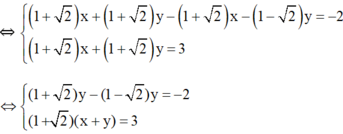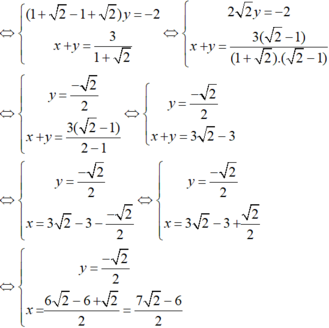Giải hệ phương trình:
1 /(2*x+1) + 3/(y-2) = 10/3 , (4*x+5) /(2*x+1) + (y-1)/(y+2) = 17/5
GIẢI HỆ PHƯƠNG TRÌNH:(đặt ẩn phụ)
a) 1/x -1/y-2 =-1
4/x + 3/y-2 =5
b)2/x +5/(x+y) =2
3/x +1/(x+y) =17/10
c) 2/(x-1) +1 /(y+1) =7
5/(x-1) - 2/(y-1) =4
d) 2/ (căn x-1) -1/ (căn y-1) =1
1/ (căn x-1) +1 / (căn y-1) =2
\(a.\left\{{}\begin{matrix}\dfrac{1}{x}-\dfrac{1}{y}-2=-1\\\dfrac{4}{x}+\dfrac{3}{y}-2=5\end{matrix}\right.\)\(\Leftrightarrow\left\{{}\begin{matrix}a-b-2=-1\\4a+3b-2=5\end{matrix}\right.\) (với \(\dfrac{1}{x}=a-\dfrac{1}{y}=b\))
\(\Leftrightarrow\left\{{}\begin{matrix}a=\dfrac{10}{7}\\b=\dfrac{3}{7}\end{matrix}\right.\)\(\Leftrightarrow\left\{{}\begin{matrix}\dfrac{1}{x}=\dfrac{10}{7}\Rightarrow x=\dfrac{7}{10}\\\dfrac{1}{y}=\dfrac{3}{7}\Rightarrow y=\dfrac{7}{3}\end{matrix}\right.\)
\(b.\left\{{}\begin{matrix}\dfrac{2}{x}+\dfrac{5}{\left(x+y\right)}=2\\\dfrac{3}{x}+\dfrac{1}{\left(x+y\right)}=\dfrac{17}{10}\end{matrix}\right.\)\(\Leftrightarrow\left\{{}\begin{matrix}2a+5b=2\\3a+b=\dfrac{17}{10}\end{matrix}\right.\) (với \(\dfrac{1}{x}=a-\dfrac{1}{x+y}=b\))
\(\Leftrightarrow\left\{{}\begin{matrix}a=\dfrac{1}{2}\\b=\dfrac{1}{5}\end{matrix}\right.\)\(\Leftrightarrow\left\{{}\begin{matrix}\dfrac{1}{x}=\dfrac{1}{2}\Rightarrow x=2\\\dfrac{1}{x+y}=\dfrac{1}{5}\Rightarrow y=3\end{matrix}\right.\)
\(c.\left\{{}\begin{matrix}\dfrac{2}{x-1}+\dfrac{1}{y+1}=7\\\dfrac{5}{x-1}-\dfrac{2}{y+1}=4\end{matrix}\right.\Leftrightarrow\left\{{}\begin{matrix}2a+b=7\\5a-2b=4\end{matrix}\right.\) (với \(\dfrac{1}{x-1}=a-\dfrac{1}{y+1}=b\))
\(\Leftrightarrow\left\{{}\begin{matrix}a=2\\b=3\end{matrix}\right.\)\(\Leftrightarrow\left\{{}\begin{matrix}\dfrac{1}{x-1}=2\Rightarrow x=\dfrac{3}{2}\\\dfrac{1}{y+1}=3\Rightarrow y=-\dfrac{2}{3}\end{matrix}\right.\)
\(d.\left\{{}\begin{matrix}\dfrac{2}{\sqrt{x-1}}-\dfrac{1}{\sqrt{y-1}}=1\\\dfrac{1}{\sqrt{x-1}}+\dfrac{1}{\sqrt{y-1}}=2\end{matrix}\right.\Leftrightarrow\left\{{}\begin{matrix}2a-b=1\\a+b=2\end{matrix}\right.\) (với \(\dfrac{1}{\sqrt{x-1}}=a-\dfrac{1}{\sqrt{y-1}}=b\))
\(\Leftrightarrow\left\{{}\begin{matrix}a=1\\b=1\end{matrix}\right.\)\(\Leftrightarrow\left\{{}\begin{matrix}\dfrac{1}{\sqrt{x-1}}=1\Rightarrow x=2\\\dfrac{1}{\sqrt{y-1}}=1\Rightarrow y=2\end{matrix}\right.\)
Giải các hệ phương trình sau:
c.{ 2(x - 2) + 3(1 + y) = 2
{ 3(x - 2) - 2(1 + y) = -3
d.{ (x - 5)(y - 2) = (x + 2)(y - 1)
{ (x - 4)(y + 7) = (x - 3)(y + 4)
e.{ 1/x - 1/y = 1
{ 3/x + 4/y = 5
e: \(\left\{{}\begin{matrix}\dfrac{1}{x}-\dfrac{1}{y}=1\\\dfrac{3}{x}+\dfrac{4}{y}=5\end{matrix}\right.\Leftrightarrow\left\{{}\begin{matrix}\dfrac{3}{x}-\dfrac{3}{y}=3\\\dfrac{3}{x}+\dfrac{4}{y}=5\end{matrix}\right.\)
\(\Leftrightarrow\left\{{}\begin{matrix}\dfrac{-7}{y}=-2\\\dfrac{1}{x}-\dfrac{1}{y}=1\end{matrix}\right.\Leftrightarrow\left\{{}\begin{matrix}y=\dfrac{7}{2}\\\dfrac{1}{x}=1+\dfrac{2}{7}=\dfrac{9}{7}\end{matrix}\right.\Leftrightarrow\left\{{}\begin{matrix}y=\dfrac{7}{2}\\x=\dfrac{7}{9}\end{matrix}\right.\)
Giải các hệ phương trình sau:
c.{ 2(x - 2) + 3(1 + y) = 2
{ 3(x - 2) - 2(1 + y) = -3
d.{ (x - 5)(y - 2) = (x + 2)(y - 1)
{ (x - 4)(y + 7) = (x - 3)(y + 4)
c) \(\left\{{}\begin{matrix}2\left(x-2\right)+3\left(1+y\right)=2\\3\left(x-2\right)-2\left(1+y\right)=-3\end{matrix}\right.\)
\(\Leftrightarrow\left\{{}\begin{matrix}6\left(x-2\right)+9\left(1+y\right)=6\\6\left(x-2\right)-4\left(1+y\right)=-6\end{matrix}\right.\)
\(\Leftrightarrow\left\{{}\begin{matrix}13\left(1+y\right)=12\\2\left(x-2\right)+3\left(1+y\right)=2\end{matrix}\right.\)
\(\Leftrightarrow\left\{{}\begin{matrix}x=\dfrac{21}{13}\\y=-\dfrac{1}{13}\end{matrix}\right.\)
d) \(\left\{{}\begin{matrix}\left(x-5\right)\left(y-2\right)=\left(x+2\right)\left(y-1\right)\\\left(x-4\right)\left(y+7\right)=\left(x-3\right)\left(y+4\right)\end{matrix}\right.\)
\(\Leftrightarrow\left\{{}\begin{matrix}xy-2x-5y+10=xy-x+2y-2\\xy+7x-4y-28=xy+4x-3y-12\end{matrix}\right.\)
\(\Leftrightarrow\left\{{}\begin{matrix}-x-7y=-12\\3x-y=16\end{matrix}\right.\) \(\Leftrightarrow\left\{{}\begin{matrix}-x-7y=-12\\21x-7y=112\end{matrix}\right.\)
\(\Leftrightarrow\left\{{}\begin{matrix}22x=124\\3x-y=16\end{matrix}\right.\) \(\Leftrightarrow\left\{{}\begin{matrix}x=\dfrac{62}{11}\\y=\dfrac{10}{11}\end{matrix}\right.\)
Giải các hệ phương trình sau:
{ (x - 5)(y - 2) = (x + 2)(y - 1)
{ (x - 4)(y + 7) = (x - 3)(y + 4)
\(\left\{{}\begin{matrix}\left(x-5\right)\left(y-2\right)=\left(x+2\right)\left(y-1\right)\\\left(x-4\right)\left(y+7\right)=\left(x-3\right)\left(y+4\right)\end{matrix}\right.\)
\(\Leftrightarrow\left\{{}\begin{matrix}xy-2x-5y+10=xy-x+2y-2\\xy+7x-4y-28=xy+4x-3y-12\end{matrix}\right.\)
\(\Leftrightarrow\left\{{}\begin{matrix}x+7y=12\\3x-y=16\end{matrix}\right.\) \(\Leftrightarrow\left\{{}\begin{matrix}3x+21y=36\\3x-y=16\end{matrix}\right.\)
\(\Leftrightarrow\left\{{}\begin{matrix}22y=20\\x+7y=12\end{matrix}\right.\) \(\Leftrightarrow\left\{{}\begin{matrix}x=\dfrac{62}{11}\\y=\dfrac{10}{11}\end{matrix}\right.\)
Giải các hệ phương trình sau:
a.{ x + 4y = -11
{ 5x - 4y = 1
b.{ 2x - y = 7
{ 3x + 5y + 22 = 0
c.{ 2(x - 2) + 3(1 + y) = 2
{ 3(x - 2) - 2(1 + y) = -3
d.{ (x - 5)(y - 2) = (x + 2)(y - 1)
{ (x - 4)(y + 7) = (x - 3)(y + 4)
e.{ 1/x - 1/y = 1
{ 3/x + 4/y = 5
a: \(\left\{{}\begin{matrix}x+4y=-11\\5x-4y=1\end{matrix}\right.\Leftrightarrow\left\{{}\begin{matrix}6x=-10\\x+4y=-11\end{matrix}\right.\Leftrightarrow\left\{{}\begin{matrix}x=\dfrac{-5}{3}\\y=\dfrac{-11-x}{4}=\dfrac{-11+\dfrac{5}{3}}{4}=-\dfrac{7}{3}\end{matrix}\right.\)
b: \(\left\{{}\begin{matrix}2x-y=7\\3x+5y=-22\end{matrix}\right.\Leftrightarrow\left\{{}\begin{matrix}6x-3y=21\\6x+15y=-66\end{matrix}\right.\)
\(\Leftrightarrow\left\{{}\begin{matrix}-18y=78\\2x-y=7\end{matrix}\right.\Leftrightarrow\left\{{}\begin{matrix}y=\dfrac{-13}{3}\\x=\dfrac{y+7}{2}=\dfrac{4}{3}\end{matrix}\right.\)
1) {x^2+2x^2=3 {2x^2+3x^2=5 2) giải theo m {x+y=2m+1 {x-y=1 3)giải theo m {x +2y=3m+2 {2x+y=3m+2 4) cho hệ. {x+3y=4m+4 {2x+y=3m+3 Tìm m để hệ có nghiệm (x,y) thỏa mãn x+y=4 HỆ PHƯƠNG TRÌNH HẾT Ạ Giúp mik với nhé
4:
x+3y=4m+4 và 2x+y=3m+3
=>2x+6y=8m+8 và 2x+y=3m+3
=>5y=5m+5 và x+3y=4m+4
=>y=m+1 và x=4m+4-3m-3=m+1
x+y=4
=>m+1+m+1=4
=>2m+2=4
=>2m=2
=>m=1
3:
x+2y=3m+2 và 2x+y=3m+2
=>2x+4y=6m+4 và 2x+y=3m+2
=>3y=3m+2 và x+2y=3m+2
=>y=m+2/3 và x=3m+2-2m-4/3=m+2/3
Giải hệ phương trình:
\(\hept{\begin{cases}\left(x-y+\frac{1}{2}\right)^2+\left(xy-3\right)^2=\frac{5}{4}\\\left(x+1\right)\sqrt{y^2+5}+\left(y-1\right)\sqrt{x^2-3}=10\end{cases}}\)
Giải hệ phương trình sau: x+y/5=x-y/3 và x/4=y/2+1
\(\left\{{}\begin{matrix}\dfrac{x+y}{5}=\dfrac{x-y}{3}\\\dfrac{x}{4}=\dfrac{y}{2}+1\end{matrix}\right.\)<=> \(\left\{{}\begin{matrix}3x+3y=5x-5y\\x=2y+4\end{matrix}\right.\)<=> \(\left\{{}\begin{matrix}2x-8y=0\\x-2y=4\end{matrix}\right.\)
<=> \(\left\{{}\begin{matrix}x-4y=0\\x-2y=4\end{matrix}\right.\)<=> \(\left\{{}\begin{matrix}y=2\\x=8\end{matrix}\right.\)
Giải hệ phương trình sau:
( 1 + 2 ) x + ( 1 − 2 ) y = 5 ( 1 + 2 ) x + ( 1 + 2 ) y = 3
Lấy phương trình (2) trừ phương trình (1), vế trừ vế ta được:


Vậy hệ phương trình có nghiệm duy nhất 
Lưu ý:

Kiến thức áp dụng
Giải hệ phương trình bằng phương pháp cộng đại số
1) Nhân hai vế của phương trình với mỗi hệ số thích hợp (nếu cần) sao cho hệ số của một trong hai ẩn bằng nhau hoặc đối nhau.
2) Áp dụng quy tắc cộng đại số để được hệ phương trình mới, trong đó có một phương trình mà hệ số của một trong hai ẩn bằng 0 (tức là phương trình một ẩn).
3) Giải phương trình một ẩn vừa thu được rồi suy ra nghiệm của hệ đã cho và kết luận.